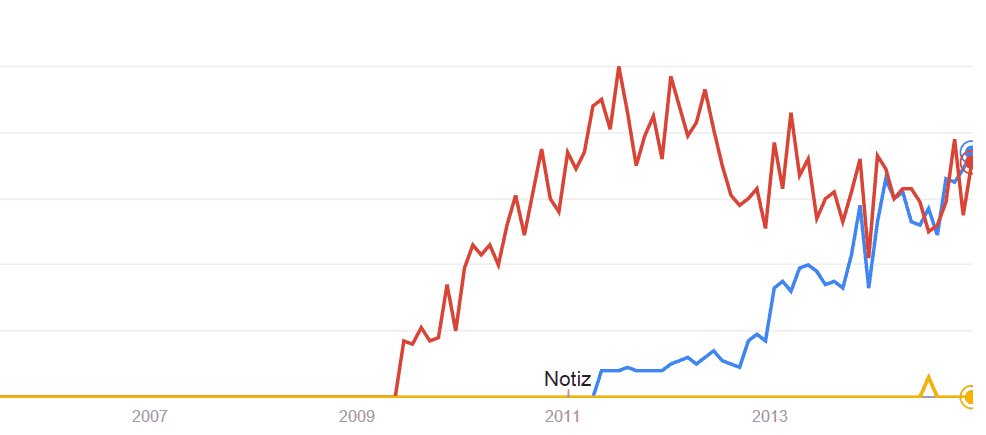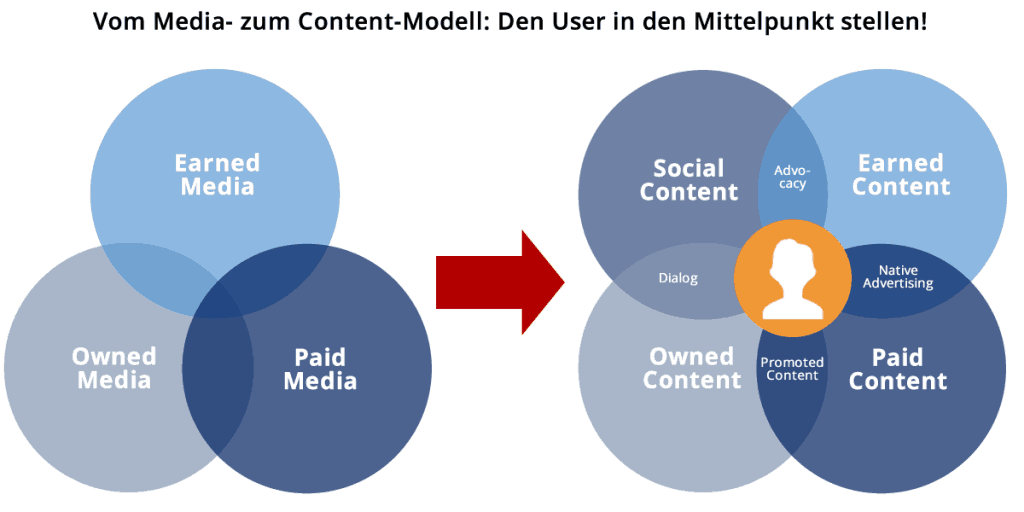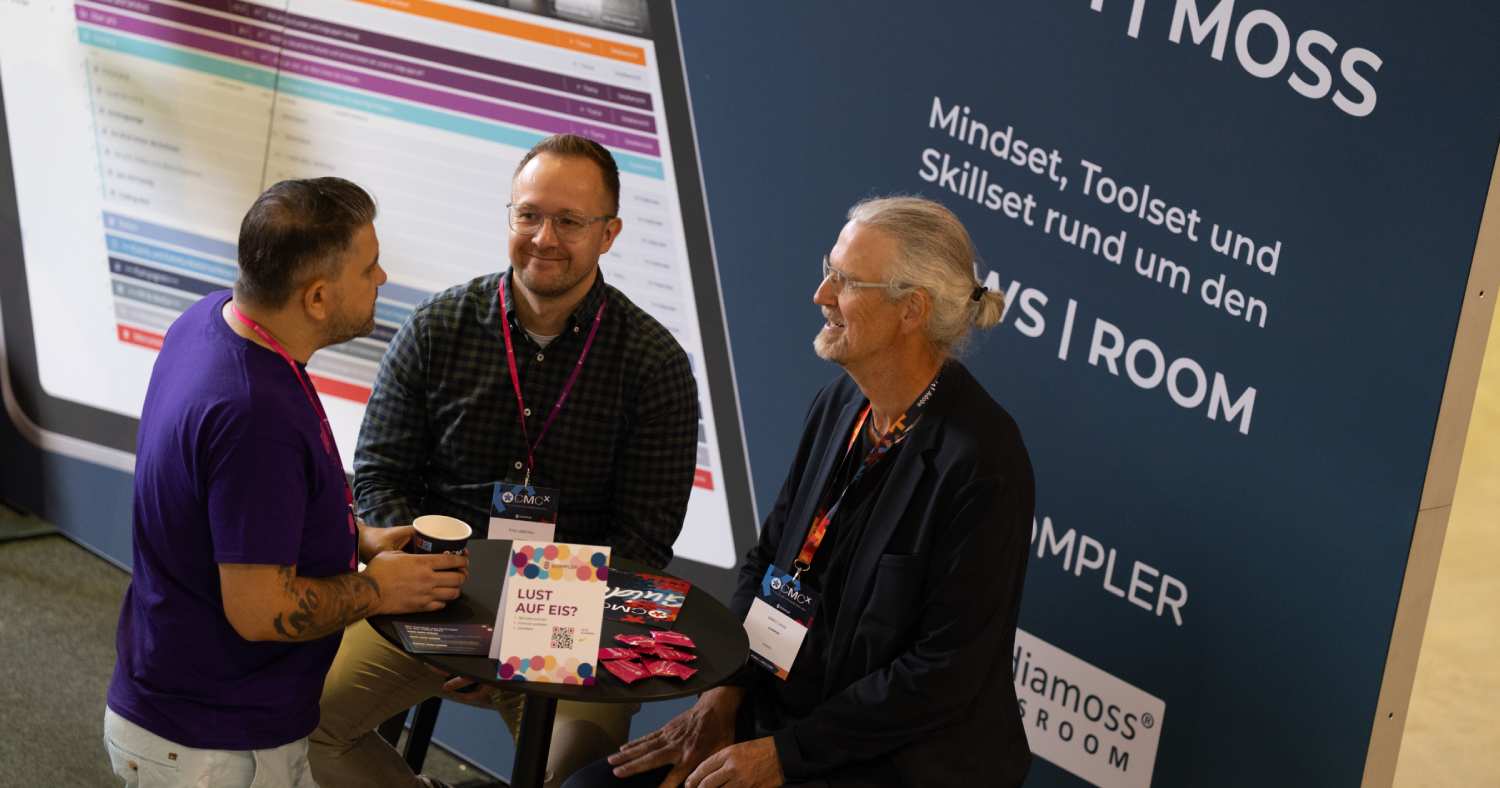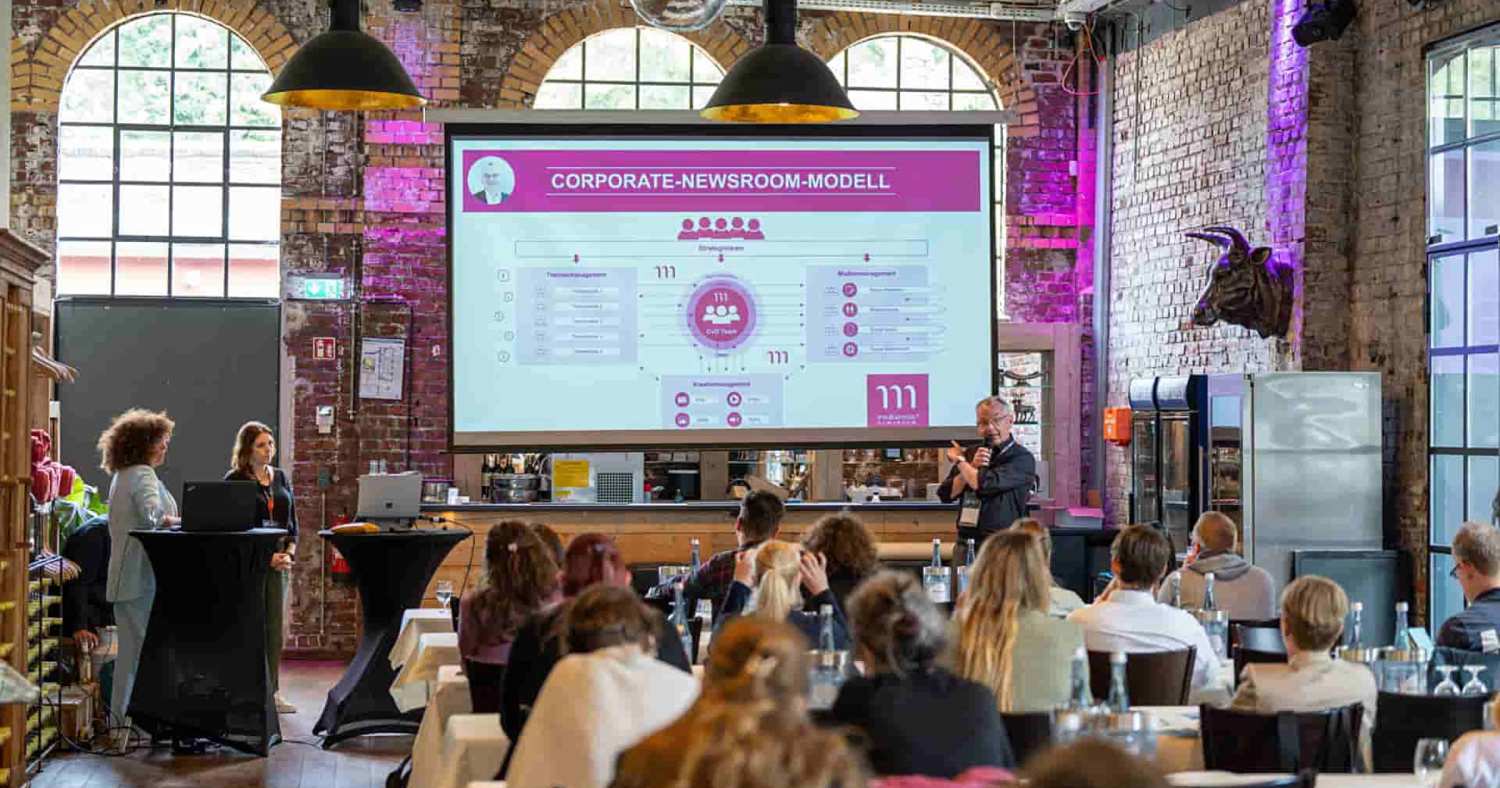Content marketing: the better social media?
"Social media" has largely failed to meet the high expectations, especially in terms of free reach gains via social networks. Many experts warned against this from the outset, pointing out that social media not only enables new forms of communication (and business), but actually requires them. Nevertheless, companies must create "reach", i.e. ensure that as many people as possible and as many of the right people as possible are aware of their messages. At least for the time being, because almost all current business models are geared towards this, and changing them takes time. This article aims to shed light on the connection between "content" or "content marketing" and "social media" and derive recommendations for action from this.
Anyone who wants to find out more about content these days is faced with an almost unmanageable mountain of buzzwords, topics, perspectives and myths. There are terms such as storytelling, personas, customer journey and added value, closely linked to social media, SEO, link building, inbound marketing and native advertising. There are lots of recipes, advice, lists, tools and how-tos, and there are articles, cover stories, conferences and barcamps everywhere; it feels like a new book is published every week: Think Content, Lean Content, Fat Content or Content Revolution. No wonder: who else, if not the "content industry", should produce content - and at the same time it also shows the weakness of the concept: in many cases, mass prevails over class, and because this is the "content about content", the problem is exacerbated. "Content" thus becomes a jack-of-all-trades, the miracle worker of modern marketing. And in the marketing departments, those responsible either praise the new messiah or moan: "Something new again?" This article is intended to give you some orientation and perhaps also some inspiration so that you can set the right course right from the start if you want to get seriously involved in the topic of "content".
Who wants to believe in the next Messiah?
Content marketing! The term came out of nowhere at the beginning of 2011. And now, almost three years later, it has climbed to the top of the (search) charts in marketing. Okay, not quite true. In fact, "SEO" is still far ahead. But at least "content marketing" (blue line) has just overtaken the previous buzz leader: "social media marketing" (red line). The fact that interest in the term "content strategy" (yellow line) only spiked once and then disappeared again is an interesting and important aspect - but more on that later. The question is: can "content" and "content marketing" fulfill the expectations that everyone had of "social media", but which have so far been bitterly disappointed? After a glut of training institutes for "social media managers", are we now experiencing a flood of "content marketing managers"? And will they (finally) manage to generate a verifiable "ROI"?

Back to basics: What is the basic idea?
Let's go back to 2008: in October, Barak Obama was elected President of the United States of America. And he won the election thanks to Twitter - to put it simply. The promise of social media was: free reach! This particularly electrified people in marketing departments. Finally becoming independent of expensive advertising! Serious social media experts keep emphasizing that you can also have a "dialogue" in social media, but hardly anyone in management wants to hear that. After all, it's work, costs money and doesn't generate sales. We! Want! Reach!
If you don't have good content, you have to pay
And this is where "content" suddenly comes into play. Because our work in social media has shown that there is a connection between "content" and "reach". This is logical, and you could have figured it out earlier, but the idea of free reach without effort was a good one. Or rather: the dream of free reach without effort. It was shattered at the latest when Facebook's "organic reach" crashed. While many managers had previously assumed that "100,000 fans" was just as good as "100,0000 newsletter subscribers", they now hit reality hard.
If you don't have good content, you have to pay to get it read.
They found that 95 percent and more of their emails end up in spam. In the figurative sense. Because they don't reach the subscribers. They are simply not displayed on Facebook. And when other people or companies report that - at least with some posts - they even reach "300 percent and more" of their fans on Facebook, then they are not math idiots but companies that create good content - which is then forwarded by their "fans" to their friends and thus multiplies their direct reach. The new reality is: if you don't have good content, you have to pay. And that's not just the case with Facebook.
Paid, earned and owned media
Which brings us to terms such as "paid media", "earned media" and "owned media". The world used to be simple. There was "advertising", for which you paid (i.e. "paid" media), and there was "PR", which you had to earn (i.e. "earned" media), and there were your own publications, for example customer magazines, which belonged to you (i.e. "owned" media). In other words: "Owned media" is like your own car, "paid media" is like a cab and with "earned media" you hitch a ride. And they were all strictly separated from each other, preferably in silos.

The discovery of the user
Unfortunately, the world today has become more complex. Even the world of communication. We all want to constantly "reduce complexity" because it is exhausting. But the world has become more complex; that's a simple fact that we have to acknowledge. The main reason for this complexity is the Internet. Because it networks everything. It ensures that more and more individual components are interdependent. The boundaries are blurring and the media are changing. From the user's point of view, there is no longer "advertising here", "a newspaper there" and a customer magazine somewhere else. Everything is merging, there are offers such as the portals of E-Plus and Saturn that look one hundred percent like editorial media.
In the age of omnichannel, the channel is no longer of interest. The user is interested in the content.
There are more and more offers in the "earned media" that the company has not "earned" at all, but for which it pays. You have to "promote" your own content so that it becomes visible at all and suddenly the supposed "owned medium" becomes a "paid medium": This is exactly what happened with Facebook and was harshly criticized by the industry.
The channel fades into the background
Anyone who delves deeper into the topic of content strategy will eventually realize how outdated and inadequate this old "media" model is. Because it makes the same mistake as so many of the (old) marketing models: it doesn't look at things from the user's perspective. And it does not take into account the special features of the digital world. Firstly, it is now only indirectly important "where" I speak (the aim is "omni-channel" anyway), it is much more important "what" I say - and "how". And secondly, the recipient doesn't just perceive what "I" say; on the Internet, everything blends into an incredible polyphony, and it can all too quickly turn into a cacophony.
How do you prevent polyphony on the social web from becoming cacophony?
Then my beautifully crafted messages are either overlaid or counteracted. The question is: how do we manage the "polyphony" (= many voices), prevent a "cacophony" (= bad voices) and perhaps even create a "symphony" (= with a common voice)?
Content as a universal component of communication
It depends on the content! Or more precisely: it depends on what content the user receives. And the user takes up different content on the topic! The model makes it clear how interwoven all disciplines are. Because from the consumer's perspective (in the middle of the graphic), everything is intertwined. Companies that are able to manage all these disciplines well will be at the forefront of the new media world. Above all, we need a "holistic view" across all possible touch points. In order to communicate effectively, we as communicators must have an influence on all areas. And one thing in particular becomes clear: how necessary it is for departments that are often organized in silos to work together. Good, modern companies are already doing this.
Stop thinking from the canal!
If you want to be really good, you use all these levers and orchestrate them. It doesn't matter "whether you are in the channel", for example, whether you have a "clipping" in the "FAZ". That is the channel-oriented way of thinking. What matters is what is in the channel. And then it is also important that the other content types in the many other channels do not lead to the cacophony described above and, for example, that all users complain in the comments at faz-online.de and on Facebook (in the comment on the link there) about what rubbish the article is (social content). Or if there is a link to the website in the article, where there are suddenly other messages (owned content). Instead, the idea is to develop the content from the core, from a common idea. The topics result in the stories and these are staged via the protagonists and formats. Only then come the channels and the specific methods of how we can also establish contact via the channels.

Does the world need more content?
But this also brings us to one of the crucial questions: does the world need more content? Is this the solution, that more and more companies are now "becoming publishers"? The answer is of course "no". Nobody needs "more" content. We need "better" content - and we need it urgently! And "better" here does not mean "more beautiful", "more colorful", "more awesome". Nor does it mean "serving more channels". It doesn't even mean "serving more channels with different content". "Better content" simply means content that does its job better! And the task of content is either to fulfill a specific information requirement or to address a "need".
The world definitely doesn't need 'more' content. But it does need a lot more 'good' content. Go for ...
The need for information here means the concrete, current desire for certain information. And needs arise from the feeling of a deficiency and the simultaneous desire to eliminate it. This applies to general topics as well as products and services. The crux of the matter is that you have to know these needs! And the more precisely you know them, the "better" the content will be.

The thing with the content (marketing) strategy
And that brings us to the point: despite all the technical, operational and creative innovations, despite all the storytelling and social media and SEO and link building and inbound marketing and native advertising - there is only one thing that is truly indispensable, without which companies will not achieve sustainable success in content marketing: STRATEGY! Even in the USA, not even 40 percent of companies have a documented strategy - although 90 percent of companies say they do "content marketing". And the situation is no different in Germany: Here the figure is just under 43 percent. And something has to change here.
Content strategy is becoming the center of content marketing, social media, online marketing and PR
A trend is a particularly profound and sustainable development - and if there's one area of content marketing that needs it, it's strategy.
Strategy is a necessity of the market
In the medium term, content marketing means a radical change in perspective, working methods and processes within companies. New skills are needed, teams have to be reorganized, budgets have to be shifted and tools have to be purchased. None of this is rocket science, but it all needs to be well planned. And this is not a question of claims by some consultants - but a very simple necessity of the market. Companies face tough competition in the content sector. It is in the nature of things that disciplines professionalize after a certain start-up time. And it is a market law that those market participants who cannot offer the same performance and quality as other market participants will not be able to hold their own in the market. And producing good content is time-consuming and expensive - nobody can afford to try things out blindly.
Saving the best for last: the ROI thing
Of course, the question arises as to the ROI, the return on investment: is it worth it? The market would prefer it if you could come up with a very simple formula along the lines of: "For every euro you invest, you get three euros out of it!" But this would be exactly the wrong way of thinking! It would almost inevitably lead to you approaching content "operationally" rather than "strategically". For example - as many currently do - you create a white paper, make it available for download, ask for the email address and then calculate how many addresses you get - and compare that with what you pay for an address elsewhere. You can do it that way, but it misjudges the true nature of content.
The understanding of content as "fuel" and "lubricant", not as a "measure"
"Content is the fuel for all your marketing and communication measures: Social media, e-mail marketing, website, corporate publishing, press relations - really everything. Without "content", all measures are nothing - we don't even want to talk about "content" or "substance". It's like driving a fleet of a dozen cars and filling them with bad fuel. They will drive badly, break down more often and therefore function inefficiently. "Content strategy" means focusing on the content and working on it. This will make every measure more effective and efficient. And you will be able to try out new, better measures.






